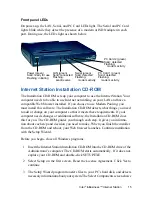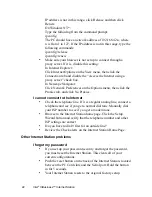
8
Intel
®
InBusiness™ Internet Station
DHCP, NAT alleviates the cost and complexity of having an IP address
for every computer on the network.
DNS
Domain Name Services simplifies Internet usage by mapping domain
names, a unique name that identifies the Internet site, to IP addresses, a
unique Internet Protocol number. It allows users to set up a distinct
domain name for a group of computers or other resource. DNS, for
example, allows the user to enter the more familiar domain name,
istation, instead of the IP address, 192.168.42.254, to communicate with
the Internet Station.
Dynamic Addressing
Dynamic Addressing on the Internet Station automatically accepts an IP
address assigned by your ISP every time you dial in. It also eliminates
complex configuration of the box. You can configure the Internet Station
to accept static addressing. Static addressing uses the same IP address
each time the Internet Station connects to your ISP.
Benefits of InstantIP technology
Cost Savings: requires less time and technical assistance
Increased Network Security: the outside only sees the Internet Station address
Simple IP Address Administration: automatic setup and maintenance
Flexibility: allows for dynamic and static configuration
To read more about InstantIP technology, access the white paper at http://
support.intel.com/support/inbusiness/internetstation.
Modem Aggregation
Modem Aggregation, a new feature for the Internet Station, improves the Internet
Station’s ability to increase the speed of access to the Internet. Modem Aggrega-
tion works by combining the speeds of 2-3 analog modems attached to the
Internet Station. When you want to send or receive information through the
Internet, the Internet Station detects which modem is free and uses that line. The
information you are sending or receiving does not have to wait in a queue until a
single modem’s line is free.
We refer to this technology as Multilink Protocol over Analog Lines and Analog
Bonding. To use the Modem Aggregation feature, your ISP must support Multilink









































